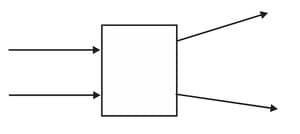Differentiate between mirror and lens.
Important Questions on Light – Reflection and Refraction
A student wants to obtain magnified image of an object AB as on a screen. Which one of the following arrangements shows the correct position of AB for him/her to be successful?
A converging lens forms a three times magnified image of an object, which can be taken on a screen. If the focal length of the lens is , then the distance of the object from the lens is _____.
If a lens can converge the sun rays at a point away from its optical centre, the power of this lens is _____.
An object is placed at a distance in front of a convex lens of focal length .
(i) Calculate the distance of the image from the lens.
(ii) Calculate the magnification of the image.
The following diagram shows the use of an optical device to perform an experiment of light.

As per the arrangement shown, the optical device is likely to be a _____.
What is meant by the optical centre of a convex lens?
A virtual, diminished image is formed when an object is placed between the optical centre and the principal focus of a lens.
(i) Name the type of lens which forms the above image.
(ii) Draw a ray diagram to show the formation of the image with the above stated characteristics.

